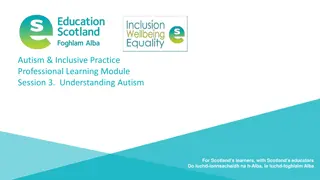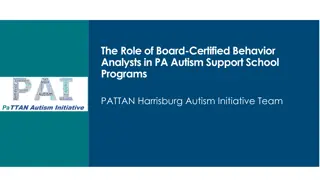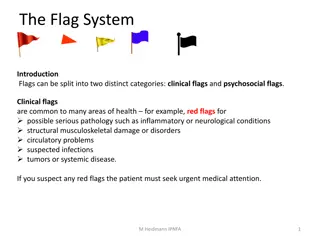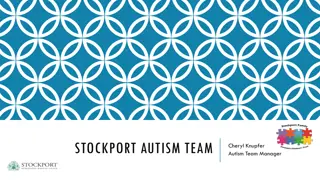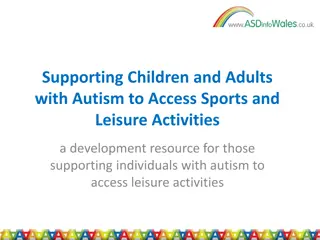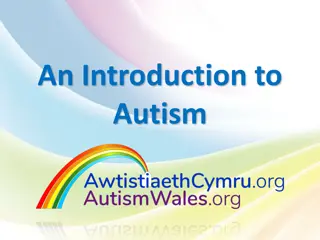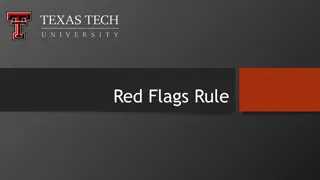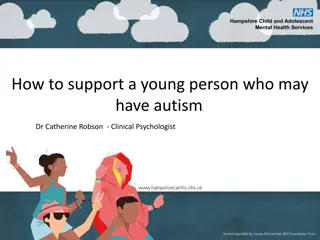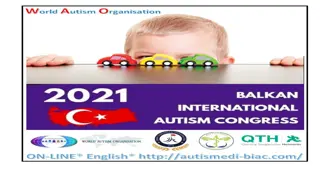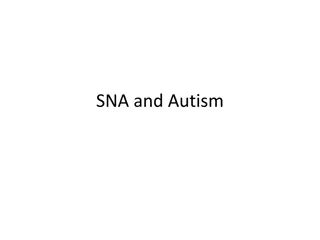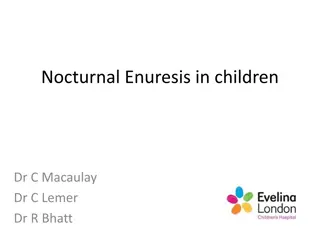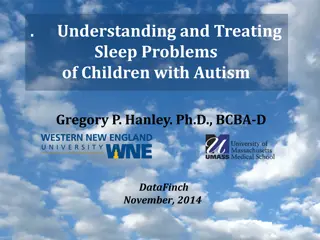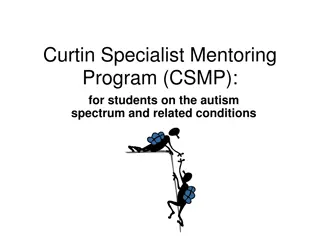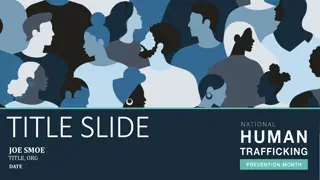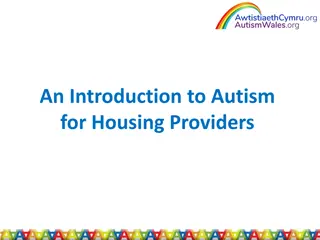Recognizing Red Flags for Autism in Children
Autism presents challenges in speech, communication, play skills, physical reactions, and behaviors. Recognizing early signs like a lack of eye contact, delayed speech, repetitive behaviors, and sensory sensitivities can help educators provide appropriate support and interventions for children on the autism spectrum.
Uploaded on Sep 06, 2024 | 4 Views
Download Presentation

Please find below an Image/Link to download the presentation.
The content on the website is provided AS IS for your information and personal use only. It may not be sold, licensed, or shared on other websites without obtaining consent from the author.If you encounter any issues during the download, it is possible that the publisher has removed the file from their server.
You are allowed to download the files provided on this website for personal or commercial use, subject to the condition that they are used lawfully. All files are the property of their respective owners.
The content on the website is provided AS IS for your information and personal use only. It may not be sold, licensed, or shared on other websites without obtaining consent from the author.
E N D
Presentation Transcript
Red Flags for Every Teacher Kara Bratton Lutheran Special Education Ministries kbratton@luthsped.org https://luthsped.org/2018/08/28/lea red red- -flags lea- -webinar webinar- - flags/
Autism: Characteristics O Speech and Communication Differences O Use few or no spoken words by age two, nor do they use gestures, gibberish, or other means to communicate their needs or thoughts. O Use only words they are repeating from television, movies, or other people, especially if they are not using the words to communicate meaning (e.g., repeating a random phrase from a favorite TV show). O Not hard of hearing but don't respond when their name is called. O Lack of eye contact, even when eye contact is requested. O Never initiating interactions or conversations with others. O Do not go through the usual babbling or gibberish stages of speech. O May develop spoken language at the usual time, but use words oddly, have an unusually flat voice, or misunderstand the intended meaning of words.
Autism: Characteristics O Play Skills O Lining up objects or toys rather than using them in pretend or interactive play; O Interacting in the same way with the same objects (toys, doors, containers, etc.) over and over again; O Enacting the same scenes (often from TV) over and over again in exactly the same way; O Engaging in "parallel play" (two children playing near one another but not interacting) long past the point when such play is developmentally typical; O Ignoring or responding angrily to attempts to join them in their play or make changes to their play schemes; O Having difficulty with age-appropriate forms of play such as rule-based games, pretend play, organized sports, or other activities that require social communication.
Autism: Characteristics O Physical Reactions and Behaviors O Rock, flap, or otherwise "stim," often as a way to calm themselves; O Over- or under-respond to sensory input, including pain; O Unusually picky eaters and may refuse foods with particular textures or strong flavors; O Unusual gait that may include toe walking or awkward movements; O Respond in age-inappropriate ways to unexpected changes in routine (angry melt-downs or extreme anxiety as a result of apparently minor changes); O Exhibit age-inappropriate behaviors or interests or have difficulty with developing age-appropriate abilities in toileting, dressing, etc.
Autism: Characteristics O Physical Symptoms O Sleep problems are common among people with autism. Many autistic children have trouble falling or staying asleep, and adults on the spectrum often have similar issues. O Many children with autism have mild or more significant delays in gross and fine motor skills; for example, they may have difficulty with manipulating silverware, using scissors, climbing, jumping, etc. O Seizure disorders are more common among children with autism. O Gastrointestinal (GI) problems such as constipation, diarrhea, and/or vomiting are more common among children with autism.
Autism: Characteristics O Hyperlexia: a very precocious ability to decode written language without the accompanying ability to understand the meaning of the text; O Synesthesia: unique responses to sound, color, letters, or numbers (for example, some people with synesthesia "see" sounds, "hear" colors, or otherwise experience unique responses to sensory input; O Savant syndrome: small percentage of the autistic population, may have amazing abilities to memorize information, do complex calculations, play piano, and so forth much like the character of Raymond in the movie "Rain Man.
Autism: Early Signs O The characteristic behaviors of autism spectrum disorder may be apparent in infancy (18 to 24 months), but they usually become clearer during early childhood (24 months to 6 years) O Most obvious signs of autism and symptoms of autism tend to emerge between 2 and 3 years of age O Any of these red flags does not mean a child has autism. But because the disorder s symptoms vary so widely, a child showing these behaviors should be evaluated by a multidisciplinary team O Under the DSM-5 criteria, individuals with ASD must show symptoms from early childhood, even if those symptoms are not recognized until later
Autism: Early Signs O No big smiles or other warm, joyful expressions by six months or thereafter O No back-and-forth sharing of sounds, smiles, or other facial expressions by nine months or thereafter O No babbling by 12 months O No gesturing (pointing, waving bye-bye) by 12 months O No words by 16 months O No two-word meaningful phrases (without imitating or repeating) by 24 months O Any loss of speech or babbling or social skills at any age
Autism: Early Signs O Doesn t make eye contact (e.g. look at you when being fed). O Doesn t smile when smiled at. O Doesn t respond to his or her name or to the sound of a familiar voice. O Doesn t follow objects visually. O Doesn t point or wave goodbye or use other gestures to communicate. O Doesn t follow the gesture when you point things out.
Autism: Early Signs O Doesn t make noises to get your attention. O Doesn t initiate or respond to cuddling. O Doesn t imitate your movements and facial expressions. O Doesn t reach out to be picked up. O Doesn t play with other people or share interest and enjoyment. O Doesn t ask for help or make other basic requests.
Risk Indicators for Preschoolers O A history of significant language delay or disorder, even if the child currently appears to have age- appropriate language abilities O Limited exposure to oral and written language before beginning school O A native language other than English O A disability that affects oral language acquisition, such as a hearing impairment O A significant history of reading difficulties in close family members O Oral language difficulties (poor vocabulary, listening comprehension, or grammatical abilities for the child s age)
Risk Indicators for Children in Kindergarten and First Grade O Poor phonological/phonemic awareness (inability to rhyme, identify initial and final sounds of spoken words, or to blend and segment one-syllable spoken words) O Lack of familiarity with basic print concepts such as (1) print conveys meaning, (2) print is read left to right, and (3) words are separated by spaces O Poor knowledge of common letter-sound relationships O Difficulty decoding unfamiliar words at the middle or end of first grade, especially as measured by reading of nonsense words such as zat
Risk Indicators for Children in Second and Third Grade O Ongoing difficulties with decoding of unfamiliar words O Slow, labored, dysfluent reading in grade- appropriate text O Poor reading comprehension O Poor spelling
Signs of Math Difficulties O Warning Signs in Preschool or Kindergarten Warning Signs in Preschool or Kindergarten O Has trouble learning to count, especially when it comes to assigning each object in a group a number O Has trouble recognizing number symbols, such as making the connection between 7 and the word seven O Struggles to connect a number to a real-life situation, such as knowing that 3 can apply to any group that has three things in it 3 cookies, 3 cars, 3 kids, etc. O Has trouble remembering numbers, and skips numbers long after kids the same age can count numbers and remember them in the right order O Finds it hard to recognize patterns and sort items by size, shape or color O Avoids playing popular games like Candy Land that involve numbers, counting and other math concepts
Signs of Math Difficulties O Warning Signs in Grade School Warning Signs in Grade School O Has trouble recognizing numbers and symbols O Has difficulty learning and recalling basic math facts, such as 2 + 4 = 6 O Struggles to identify +, and other signs and use them correctly O May still use fingers to count instead of using more sophisticated strategies O Has trouble writing numerals clearly or putting them in the correct column
Signs of Math Difficulties O Has trouble coming up with a plan to solve a math problem O Struggles to understand words related to math, such as greater than and less than O Has trouble telling his left from his right, and has a poor sense of direction O Has difficulty remembering phone numbers and game scores O Avoids playing games like Risk that involve number strategy O Has trouble telling time
Indicators of Learning Disabilities O Preschool Preschool O Speaks later than most children O Pronunciation problems O Slow vocabulary growth, often unable to find the right word O Difficulty rhyming words O Trouble learning numbers, alphabet, days of the week, colors, shapes O Extremely restless and easily distracted O Trouble interacting with peers O Difficulty following directions or routines O Fine motor skills slow to develop
Indicators of Learning Disabilities Grades K Grades K- -4 4 O Slow to learn the connection between letters and sounds O Confuses basic words (run, eat, want) O Makes consistent reading and spelling errors including letter reversals (b/d), inversions (m/w), transpositions (felt/left), and substitutions (house/home) O Transposes number sequences and confuses arithmetic signs (+, -, x, /, =) O Slow to remember facts O Slow to learn new skills, relies heavily on memorization O Impulsive, difficulty planning O Unstable pencil grip O Trouble learning about time O Poor coordination, unaware of physical surroundings, prone to accidents O
Indicators of Learning Disabilities O Grades 5 Grades 5- -8 8 O Reverses letter sequences (soiled/solid, left/felt) O Slow to learn prefixes, suffixes, root words, and other spelling strategies O Avoids reading aloud O Trouble with word problems O Difficulty with handwriting O Awkward, fist-like, or tight pencil grip O Avoids writing assignments O Slow or poor recall of facts O Difficulty making friends O Trouble understanding body language and facial expressions
Indicators of Learning Disabilities O High School Students and Adults High School Students and Adults O Continues to spell incorrectly, frequently spells the same word differently in a single piece of writing O Avoids reading and writing tasks O Trouble summarizing O Trouble with open-ended questions on tests O Weak memory skills O Difficulty adjusting to new settings O Works slowly O Poor grasp of abstract concepts O Either pays too little attention to details or focuses on them too much O Misreads information
Indicators of ADD/ADHD O Some signs of hyperactivity-impulsivity are: O Feeling restless, often fidgeting with hands or feet, or squirming while seated O Running, climbing, or leaving a seat in situations where sitting or quiet behavior is expected O Blurting out answers before hearing the whole question O Having difficulty waiting in line or taking turns.
Indicators of ADD/ADHD O Some signs of inattention: O Often becoming easily distracted by irrelevant sights and sounds O Often failing to pay attention to details and making careless mistakes O Rarely following instructions carefully and completely losing or forgetting things like toys, or pencils, books, and tools needed for a task O Often skipping from one uncompleted activity to another.
Indicators of ADD/ADHD Because everyone shows some of these behaviors at times, the diagnosis requires that such behavior be demonstrated to a degree that is inappropriate for the person's age. The diagnostic guidelines also contain specific requirements for determining when the symptoms indicate ADHD. The behaviors must appear early in life, before age 7, and continue for at least 6 months. Above all, the behaviors must create a real handicap in at least two areas of a person's life such as in the schoolroom, on the playground, at home, in the community, or in social settings. So someone who shows some symptoms but whose schoolwork or friendships are not impaired by these behaviors would not be diagnosed with ADHD. Nor would a child who seems overly active on the playground but functions well elsewhere receive an ADHD diagnosis. To assess whether a child has ADHD, specialists consider several critical questions: Are these behaviors excessive, long-term, and pervasive? That is, do they occur more often than in other children the same age? Are they a continuous problem, not just a response to a temporary situation? Do the behaviors occur in several settings or only in one specific place like the playground or in the schoolroom? The person's pattern of behavior is compared against a set of criteria and characteristics of the disorder as listed in the Diagnostic and Statistical Manual of Mental Disorders (DSM-IV- TR.) ldonline.org O O
Process for Evaluation O Understand the local school district s procedures O Have documentation ready O Any medical diagnoses O Documentation of parent and/or school concerns O Documentation of interventions (see Intervention Plan) O Documentation of any benchmark assessments/standardized tests O Documentation of any behavioral concerns O Understand that if documentation is limited or does not show interventions attempted by school, or that the student is young and has not had much time to progress academically with interventions, request for evaluation from school district will likely be denied O Private evaluation may be pursued by parent, but this does not automatically qualify student for IEP/ISP
Process for Evaluation O Think about the purpose of possible evaluation O Young children, while eligible for Child Find, are often difficult to assess or for assessment to show information needed for diagnosis O Assessment results are a major determinant of eligibility so age does need to be considered depending on the potential diagnosis O What information does the teacher/school need in order to help the child? Are interventions and supports currently helping the child succeed? What information could be added from an evaluation that would change instruction?
Process for Evaluation O Meet with parents when you have concerns O Discuss if the difficulties are new or recurring. Parents can share information from previous years and home observations O Is the difficulty constant or isolated? Teacher can document difficulties that are not isolated with dates O Is the difficulty appropriate for children of this age or is it an atypical difficulty O Develop a plan based on meeting O Keep parents informed about any changes and progress O If determined interventions are not producing improvement, moving on to a referral or pre-referral (depending on district procedures) may be helpful
What To Look For O Risk Indicators O Response to Accommodations and Interventions O Behaviors O Parental Input O Observe and document all of these! O Intervention Plan (on website link) O Accommodations Checklists (on website link)
Intervention & Documentation O Special education shall not act upon a referral without documented program modifications. O Grab a folder or notebook that you will use to collect documentation about your interventions, accommodations, and modifications for the student. Include dates and details. It is also advisable to keep a record of the phone and email correspondences you have with parents and relevant school personnel. O If you have not yet tried any accommodations or modifications to support the child s needs in your classroom, consult with others (teachers, the resource specialist, or the school psychologist) about ways to help your student. O Inform the student s parent about your concerns. Find out what their perspective is on the issue. Let them know what interventions you are considering. Find out if they have effective interventions they use at home.
Intervention & Documentation Once you have selected an intervention to try, select a metric you will use to measure improvement. The metric should be observable or recordable (e.g., measured increase in reading fluency; measured decrease in the number of outbursts in a week). Make sure to include the dates of intervention, record progress notes, and to decide in advance how long is a reasonable time frame to expect progress. If you have already tried some interventions, document what you have done retroactively, including the dates and metrics you are using to measure progress. Do a self-assessment: Were the interventions tried for a reasonable time period? Were the interventions implemented systematically and appropriately considering the child s needs such that I would expect progress with a typically developing child? If you need more evidence about the efficacy of an intervention, adjust your approach accordingly. If you have exhausted your own resources and your student is not making measurable progress (on the metric you selected) with the interventions you have tried, then you have some evidence that your student may require special education. O O O
Intervention & Documentation O An intervention plan should be in place long enough to judge with confidence whether that plan is working. It is recommended that RTI Teams set a reasonable default length of time that intervention plans will be in effect (e.g., 6 to 8 instructional weeks). However, teams should also have the latitude to set longer or shorter intervention timespans based on the facts of the specific student case. rtinetwork.org
Intervention & Documentation How many intervention plans should the RTI Team implement before How many intervention plans should the RTI Team implement before deciding that a student has failed to adequately respond to general deciding that a student has failed to adequately respond to general- - education interventions? education interventions? Each school district must develop its own decision rules for judging when a series of general- education intervention plans have failed to work and for deciding that a student is not responding adequately to intervention. The foundation assumption of RTI is that students in general education who begin to experience academic or behavioral problems are typical learners and that it is the school s responsibility to find strategies that will allow those students to experience success. A district s RTI decision rules for a referral to special education should require evidence beyond a reasonable doubt that a student is not responding to general- education interventions. For many districts, these decision rules require that a minimum of 3 separate intervention plans be attempted with each intervention plan being tried for at least 6 to 8 instructional weeks before the school can adequately judge whether a given student has or has not responded to intervention. rtinetwork.org O O
Tools ADDES 4 (Attention Deficit Disorder Evaluation Scale-4th Edition)- https://www.hawthorne-ed.com/pages/adhd/ad1.html ADD/ADHD Online Screen: https://www.additudemag.com/adhd- symptoms-test-children/?src=embed_link Modified Checklist for Autism in Toddlers (M-CHAT-R)- https://www.autismspeaks.org/what-autism/diagnosis/screen-your- child DSM 5 Checklist (website link) DSM 5 Diagnostic Criteria- https://www.autismspeaks.org/what- autism/diagnosis/dsm-5-diagnostic-criteria Ages and Stages Questionnaire- https://www.asqonline.com/family/993-screening-family-access-open- asq-3-english/start O O O O O O
Tools O Early Learning Observation and Rating Scale (puts focus on signs of learning disabilities)- O http://www.getreadytoread.org/screening-tools/early-learning-observation- rating-scale/elors-the-observation-forms O Get Ready to Read Screening Tool- O http://www.getreadytoread.org/screening-tools/grtr-screening- tool/the-tool O Getting Ready for Kindergarten O Parent Checklists O http://www.getreadytoread.org/images/content/downloads/Kindergarten_R eadiness_Toolkit/Handouts/getting_ready_for_kindergarten_handouts.pdf O Teacher Checklists O http://www.getreadytoread.org/images/content/downloads/Kindergarten_R eadiness_Toolkit/03_kindergarten_readiness_checklist.pdf O http://www.getreadytoread.org/images/content/downloads/Kindergarten_R eadiness_Toolkit/04_readiness_indicators_observation_guide.pdf
Assessments O Universal Screeners/Benchmark Assessments/Progress Monitoring O DIBELS Next: https://dibels.org O Aimsweb: http://www.aimsweb.com O EasyCBM (free and paid versions available; paper/pencil and online assessments) O https://www.easycbm.com O Entrance Screener/Brief Achievement O WRAT 4 or 5: https://www.pearsonclinical.com/education/prod ucts/100001722/wide-range-achievement-test-4- -wrat4.html
Assessments O In depth Academic Achievement O WJIV: http://www.hmhco.com/hmh- assessments/clinical-and-special-needs- assessment/wj-iv O Brigance (also Early Childhood): https://www.curriculumassociates.com/prod ucts/BRIGANCEoverview.aspx O Key Math: https://www.pearsonclinical.com/education/ products/100000649/keymath3-diagnostic- assessment.html
Reading and Math Resources O Florida Center for Reading Research Student Center Activities: Reading O http://www.fcrr.org/for-educators/sca.asp O National Council of Teachers of Mathematics: Focal Points Activities O http://illuminations.nctm.org/Default.aspx O Reading Rockets O http://www.readingrockets.org/guides/other O http://www.readingrockets.org/guides/readingrockets O http://www.intensiveintervention.org/sample-lessons-activities O http://www.doe.virginia.gov/instruction/mathematics/element ary/number_sense_module/nns_modules_2012.pdf O Chris Woodin Math: https://sites.google.com/a/woodinmath.com/main/home O Teach4Mastery Math: https://teach4mastery.com
Reading and Math Resources O Bob Sornson Early Learning Foundation O http://earlylearningfoundation.com/publicati ons/ O Essential Skill Inventories O The Math MOMS & DADs Home Program O Hawthorne Intervention Manuals- https://www.hawthorne- ed.com/pages/home%20page/interventionman uals.html
Stay in Touch! O Luthsped.org O Sign up for our free e-newsletters O Always available for FREE consultations O Available for professional development for schools and churches




